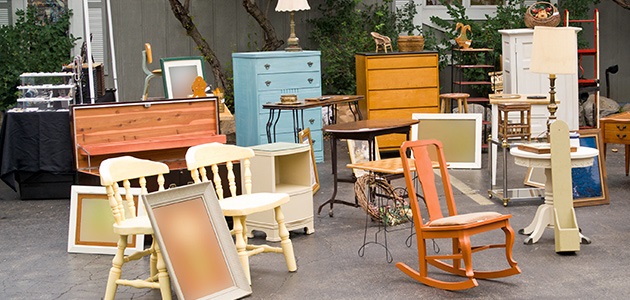
If you have some junk in your home, now might be the perfect time to sell them. But why not think bigger and involve your neighbors too! A jumble sale is a great idea for a few reasons: first, more people are involved, the greater the foot traffic will be because yard sale enthusiasts love being efficient with their time and thrifting. Having several homes to visit without having to walk or drive to a new location is something they will appreciate. Secondly, a street sale is a great way to meet new neighbors and re-establish connections with old ones. As an added bonus, it’s great for the environment too!
Planning a street sale isn’t necessarily that much more work than organizing your own yard sale. The bulk of the work will still be collecting your items, cleaning and fixing anything that needs a bit of sprucing up, and pricing your goods. When you’re involving other homes, choosing a date that works for everyone and getting permits, if needed, is really the only extra work you’ll need to do.
How to plan a street sale
- Contact other residents on your street. You can knock on doors, but it might be more efficient to make first contact with a letter. You can explain your idea, give a couple of dates to choose from and ask the resident to phone or email you by a certain date if they are interested in participating. Make sure to clearly identify who you are and where you live.
- Determine if you need a permit. If you are planning to close your street to traffic, you will absolutely need a permit. You may not need one if the street is going to remain open, but always check your city or town’s by-laws to make sure your sale won’t violate your neighborhood covenants.
- Advertise your sale. Don’t rely on word of mouth or accidental foot traffic. Spread the word far and wide! Use social media, sites like Craigslist, advertise in local newspapers, and put up signs around your community. . Just make sure to take all those signs down immediately after the sale, and double check to make sure you are allowed to post signs in your neighborhood.
- Determine if you want to donate to charity. Sometimes families decide to donate a portion of the proceeds from a street sale to a local community charity. This will sometimes encourage more shoppers to come out and support the sale, plus it’s just a nice thing to do. It will be an honor system situation: you’ll have to trust that other families are going to donate if they say they will. You will be responsible for collecting their donation and delivering it to the agreed-upon charity at the end of the sale.
- Consider a lemonade stand. It’s a street sale, so shoppers may be browsing for quite some time and might enjoy a refreshing drink. This is a great opportunity for kids in the neighborhood to make a little cash too! If you have concerns about hygiene, sell bottles of water or pop instead.
Sale tips and advice
- Be critical. Yes, you want to get rid of that ratty robe your husband has had for 15 years, but will anyone else actually want to buy it? Sometimes old junk is just old junk. Look at each item critically and think about whether or not it’s really something someone else will purchase.
- Know the value of an item. Sometimes we have valuable treasures lurking in our basements and attics. Before pricing that old Star Wars toy at $0.15 or slapping a $1 tag on the oil painting Aunt Edna left you, make sure they’re not rare collectibles or valuable antiques. Sites like eBay are a good way to guestimate the worth of potentially valuable items.
- Price to sell. The idea of a yard sale is to purge unwanted items, so make sure you’re not pricing yourself out of business – don’t forget, at a street sale there is competition. People are looking to find bargains and walk away with change in their pockets, so if they don’t find them at your home they’ll go to your neighbor’s instead.
- Be prepared to make deals. Haggling is a part of the yard sale process, and your shoppers will expect that they can make deals. They’re not being rude or cheap – it’s just what’s done. Price your items slightly higher than you hope to sell them for to leave wiggle room. For example, if you hope to make $0.50 from an old mixing bowl, price it at $0.75 or a $1.00. Remember, you don’t want to have to haul all your stuff back into the house, so sometimes it’s better to take a loss and just let it go.
- Clean and polish. No one wants a pair of dirty pants or a dusty lamp. Wash clothing and dishes, polish shoes, wipe down furniture and small appliances, and give toys a good bath. The better you make your items look, the faster they’ll sell.
- Offer a change room. If you have lots of clothing to sell, consider creating a makeshift change room in your garage. Set up partitions using a laundry line and sheets or blankets so your shoppers can try on your items before they buy.
- Make sure you can make change. Go to the bank before your sale and get lots of change and small bills. Get two rolls of quarters, a stack of 50 $1 bills, 10 $5 bills and 5 $10 bills.
At the end of your sale, if you and your neighbors’ have unsold items, consider donating them to Goodwill or the Salvation Army, or another local charity thrift shop.
416163C CAN/US (05/18)




